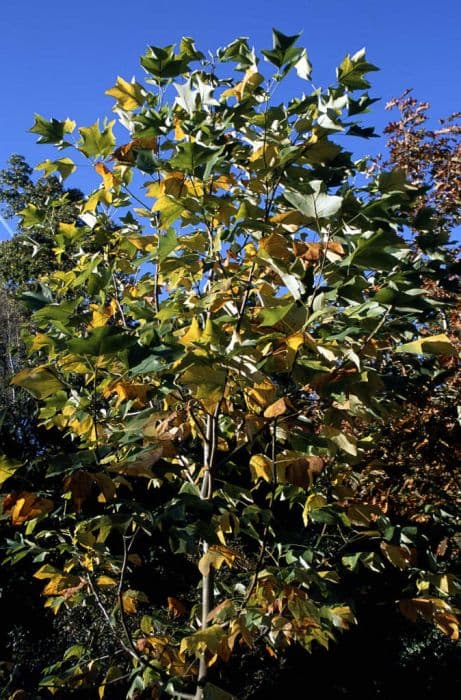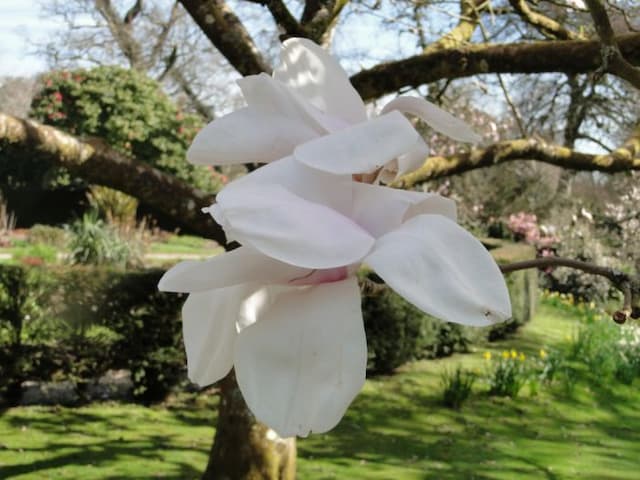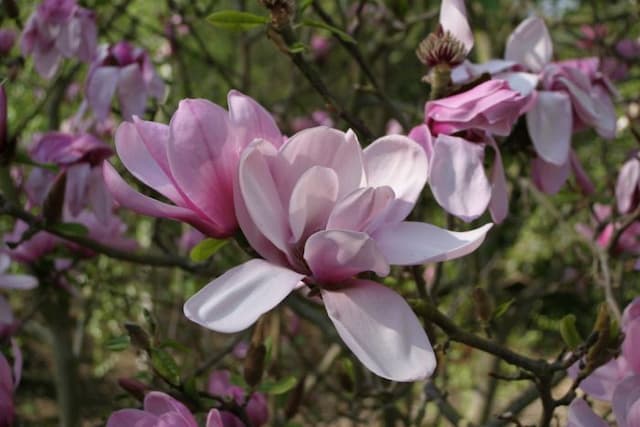Magnolia Magnolia 'Judy'

ABOUT
Magnolia 'Judy' is a visually striking plant, characterized by its large, showy flowers that are the hallmark of the magnolia family. These blossoms are typically a captivating pink or blush-purple color, making them quite distinctive and a favorite among garden enthusiasts. The flowers are cup-shaped with broad petals that open up from fuzzy buds, giving off a pleasant fragrance that can attract passersby as well as pollinators like bees. The glossy green leaves of Magnolia 'Judy' provide a beautiful backdrop for the flowers, highlighting their color and form. These leaves are oval-shaped with a leathery texture and may have a smooth, waxy surface, which helps in water retention. They tend to be arranged alternately on sturdy branches that create a dense foliage canopy. As the seasons change, the plant also goes through a transformation, with its leaves taking on warm shades before dropping, and its flowers giving way to cone-like fruiting bodies. These fruits often contain bright red seeds that can attract birds and other wildlife to the garden. Magnolia 'Judy' is a deciduous plant, meaning it will shed its leaves annually, which adds to its dynamic appeal in a garden setting.
About this plant
 Names
NamesFamily
Magnoliaceae.
Synonyms
Judy Magnolia, Magnolia 'Judy'.
Common names
Magnolia 'Judy'
 Toxicity
ToxicityTo humans
Magnolia 'Judy' is not considered toxic to humans. However, it is always advisable to not consume parts of ornamental plants due to potential individual allergic reactions or the presence of substances that might cause discomfort if ingested in large quantities.
To pets
Magnolia 'Judy' is also not considered toxic to pets. Like humans, pets should not consume plant material as it may result in gastrointestinal discomfort or an allergic reaction, but magnolias are not known to be poisonous to pets.
 Characteristics
CharacteristicsLife cycle
Perennials
Foliage type
Deciduous
Color of leaves
Green
Flower color
Pink
Height
10 feet [3 meters]
Spread
8 feet [2.44 meters]
Plant type
Tree
Hardiness zones
5
Native area
Southeast United States
Benefits
 General Benefits
General Benefits- Ornamental Appeal: The Magnolia 'Judy' offers large, fragrant pink blossoms in the spring, enhancing the aesthetic appeal of gardens.
- Landscape Versatility: This magnolia can be used as a specimen plant, or incorporated into mixed borders and woodland gardens.
- Wildlife Attraction: The flowers provide nectar for bees and other pollinators, while the tree can offer shelter for birds.
- Seasonal Interest: A deciduous magnolia, 'Judy' features a changing landscape throughout the seasons from blossoming flowers, to lush greenery, and then to warm autumnal foliage.
- Low Maintenance: Once established, Magnolia 'Judy' generally requires minimal care, making it suitable for gardeners of all skill levels.
- Shade Provision: As the tree matures, it can provide a substantial amount of shade, making it a valuable addition to yards and outdoor living spaces.
 Medical Properties
Medical PropertiesThis plant is not used for medical purposes.
 Air-purifying Qualities
Air-purifying QualitiesThis plant is not specifically known for air purifying qualities.
 Other Uses
Other Uses- Perfume Industry: The delicate scent of the Magnolia 'Judy' flowers can be used in perfumery to create fragrant compositions.
- Dye Production: The pigments in Magnolia 'Judy' petals could potentially be used to create natural dyes for textiles or art materials.
- Photography: The stunning flowers and leaves can provide an excellent subject for botanical photography and art.
- Culinary Decoration: The petals of Magnolia 'Judy' can be used as an elegant, edible garnish for sophisticated dishes.
- Weddings and Events: Its blooms can be incorporated into floral arrangements for weddings and other special occasions.
- Horticultural Therapy: The process of growing and caring for Magnolia 'Judy' can be utilized as a therapeutic activity to improve mental well-being.
- Educational Resource: The plant can serve as a living specimen for educational purposes, teaching about botany and plant life cycles.
- Landscape Painting: The characteristic shape and color of the Magnolia 'Judy' make it an excellent subject for landscape and botanical paintings.
- Handmade Paper: The fibers from the bark or leaves may be used in the production of unique, textured handmade papers.
- Organic Mulch: Fallen leaves and flowers of the Magnolia 'Judy' can be composted and used as mulch, contributing to soil health.
Interesting Facts
 Feng Shui
Feng ShuiThe Magnolia is not used in Feng Shui practice.
 Zodiac Sign Compitability
Zodiac Sign CompitabilityThe Magnolia is not used in astrology practice.
 Plant Symbolism
Plant Symbolism- Nobility: Magnolias have been associated with nobility due to their impressive appearance and long-standing status in gardens of the affluent.
- Persistence: Their ability to withstand harsh climates and still bloom beautifully represents persistence and endurance.
- Dignity: The elegant form of magnolias signifies dignity and poise.
- Strength: Magnolias are robust and strong trees, symbolizing inner strength and resilience.
- Femininity: The soft petals and rounded form of magnolias are often linked to the grace and gentleness of femininity.
- Purity: The pure white color of many magnolia flowers embodies purity and innocence.
 Water
WaterThe Judy Magnolia should be watered deeply once a week during the growing season, with adjustments made for rainfall and heat conditions. Mature trees benefit from approximately 1.5 to 2 gallons of water. During the dormant winter season, reduce watering; however, do not allow the soil to become completely dry. It's crucial to avoid waterlogging the soil to prevent root rot, so ensure proper soil drainage. The amount of water provided may need to be increased during periods of extreme heat or drought.
 Light
LightThe Judy Magnolia thrives best in full sunlight to partial shade. Ideally, it should be placed where it can receive at least 4 hours of direct sunlight daily. The more sunlight the tree receives, the better it will bloom; however, in extremely hot climates, some afternoon shade can be beneficial to prevent overheating.
 Temperature
TemperatureThe Judy Magnolia is adaptable but prefers temperatures between 70°F and 85°F for optimal growth. It can withstand minimum winter temperatures down to about 0°F. To ensure healthy growth, avoid exposure to extreme temperature fluctuations and protect the plant from frost during its tender early spring growth stages.
 Pruning
PruningPrune the Judy Magnolia to maintain its shape and remove any dead or diseased wood. Pruning should occur after flowering in late spring or early summer to avoid cutting off next year's buds. Occasional thinning out of the canopy can increase sunlight penetration and air circulation, improving the overall health of the tree.
 Cleaning
CleaningAs needed
 Soil
SoilMagnolia 'Judy', commonly known as Judy Magnolia, thrives best in rich, well-draining soil with a slightly acidic pH of 5.0 to 6.5. A good mix would consist of loamy garden soil, peat moss, and compost to enhance fertility and drainage.
 Repotting
RepottingJudy Magnolia, being a larger shrub or small tree, does not require frequent repotting. It is typically planted directly into the ground and may need transplantation only if it outgrows its space or conditions are unsuitable.
 Humidity & Misting
Humidity & MistingJudy Magnolia prefers moderate humidity levels but is adaptable to the humidity conditions of most temperate climates; it does not have specific high humidity requirements.
 Suitable locations
Suitable locationsIndoor
Provide bright light, keep soil slightly moist, protect from drafts.
Outdoor
Full sun, well-drained soil, protect from strong winds.
Hardiness zone
4-8 USDA
 Life cycle
Life cycleThe Magnolia 'Judy' begins its life as a seed that germinates in the spring, requiring well-drained soil and adequate warmth. Once sprouted, the seedling grows into a young plant, developing its root system and foliage through photosynthesis. As it matures, 'Judy' Magnolia develops its characteristic large, fragrant flowers, usually blooming in the spring and sometimes sporadically in the summer. After pollination, typically by beetles attracted to its flowers, the plant sets seeds encased in cone-like fruiting structures. The seeds are then dispersed, often by birds, to initiate a new life cycle. Throughout its life, which can span several decades, the Magnolia 'Judy' undergoes periods of growth and dormancy, typically aligning with seasonal changes.
 Propogation
PropogationPropogation time
Spring-Early Summer
Magnolia 'Judy', a decorative and striking flower-bearing tree, is commonly propagated through the process of softwood cuttings, which is typically carried out in late spring or early summer when the plant's new growth is still flexible. During the appropriate time, a gardener would take cuttings of about 4 to 6 inches (10 to 15 centimeters) in length from new growth, ensuring each cutting has at least two sets of leaves. The lower leaves are removed and the cut end dipped in rooting hormone powder to stimulate root growth. The prepared cuttings are then placed in a pot filled with a well-draining potting mix, covering the lower third of the cutting. The pot must be kept in a warm environment with indirect light and the soil kept consistently moist until roots develop, which usually takes several weeks. Care must be taken to avoid direct sunlight on the new cuttings as it can cause excessive heat that may damage the developing roots.









![Magnolia [Felix Jury]](/_next/image?url=https%3A%2F%2Fplants-admin.emdemapps.com%2Fimages%2Fplants%2F%2Fimages%2F604b61a0b23b7.png&w=640&q=75)